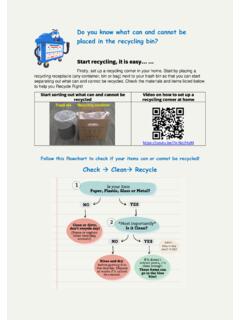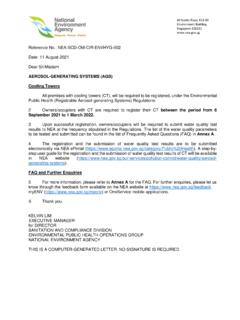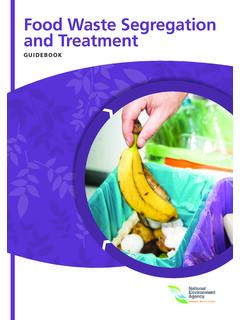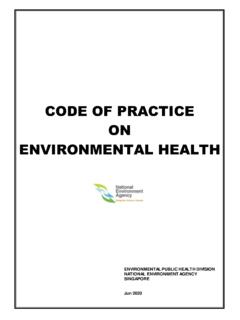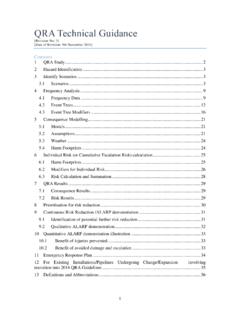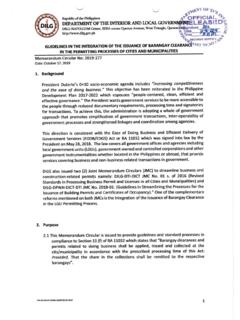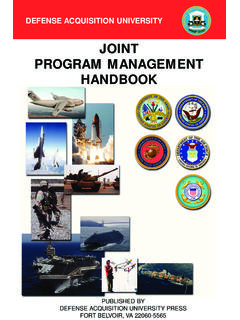Transcription of Plastic Waste Management in Singapore
1 Workshop for Competitive Research Programme on Segregation and Value Recovery for Plastics Plastic Waste Management in SingaporeJaren SooExecutive Engineer (WRMD/P&D)13 Apr 20182 ObjectivesBy the end of this presentation, we hope the participants will be able to: an appreciation of Singapore s Waste Management strategies the Plastic Waste situation in Singapore possible R&D scope that can address the local challenges in relation to Plastic Waste management1 Overview of Singapore s Waste Management Strategies3 With specific focus on Plastic waste4 Key Challenges Waste Growth and Land Scarcity11 LandfillWTE PlantEvery 7-10 yearsEvery 30-35 yearsAt the current rate of Waste disposal, we will need to build:Semakau LandfillSets out the national vision and plans for the next phase of sustainable developmentSustainable Singapore Blueprint 2015 (SSB2015)AZero Waste NationA Vibrant & Sustainable CitySSB 2030 Targets70%30%81%Overall recycling rateDomestic recycling rateNon-domestic recycling rate6 Waste Management StrategiesTowards a Zero Waste Nation RecyclingMaximise resource recovery from wasteAdopt viable & efficient recycling methods for environmental sustainabilityWaste Minimisation / PreventionRight-price Waste disposal servicesPromote efficient use of resources in production processesWaste-to-Energy / Volume ReductionAdopt innovative technologies to maximise energy recovery, and minimise land-take & ash residueLandfillMinimise landfilling demand and maximise landfill lifespan7 General Plastics Material Flow in SingaporeManufacturingConsumptionRecycli ngDisposal atWtEPlantsRetailPost-manufacturing wasteSorting/ ProcessingPost-consumer wasteRe-manufacturing2 Strategy 1: Waste minimisation/ Prevention89 Strategy 1.
2 Waste Minimisation/PreventionVoluntary industry-government platform to promote packaging Waste 3Rs1stSPA launched in July 200739,000tonnes of packaging Waste avoided & SGD93 milsavedRecipients of SPA Awards 2017 with Minister Masagos Zulkifli at the SPA Awards Ceremony and Gala Dinner on 5 June 20172ndSPA has been extended till 2020 LaunchedPackaging Benchmark DatabaseEnhancedRecognition under SPA AwardsIntroduceMandatory Requirements by 2021 Singapore Packaging AgreementAnnual 3R Packaging/SPA Awards booklets with the commendable work done by the winnersPromoteLogo for Products with Reduced PackagingThe Logo for Products with Reduced Packaging10 Strategy 1: Waste Minimisation/PreventionCommercial premises can benefit by recycling more and saving on Waste disposal costLarge hotels & malls are required by law to submit Waste disposal and recycling data, Waste reduction plans & targets since2015 Working with hotels and malls to improve their Waste Management practicesPremises can tap on 3R Fund to co-fund initiatives on Waste minimisation and recyclingMandatory Waste ReportingNEA and MEWR have disallowed the use of disposables for dine-in at new hawker centresExamples of these new hawker centresinclude Yishun Park, PasirRisCentral, and Our Tampines HubNEA is continuously working with stakeholders to encourage the use of reusablesDisallowed use of disposables for dine-in11 Strategy 1.
3 Waste Minimisation/PreventionPlastics25%Other waste75%Breakdown of Waste disposed ofin 201712 Problem Statement With growing amount of Waste generated in Singapore , a part of it is attributed to the prevalent use of plastics including single-use plastics (disposables) due to several factors such as need for convenience, protection of products, prevention of cross contamination of food items. Excessive packaging ( for some types of packaged products) is also a key concern as it is a Waste of precious resources and puts a strain on our Waste Management infrastructure. How can R&D help to enable use of plasticin a more sustainable manner, and facilitate a reuse culture, while maintaining comparable levels of convenience, protection, aesthetics and other functionalities? 3 Strategy 2: Recycling1314 Strategy 2: RecyclingRecycling of Domestic WastesNational Recycling Programme (NRP)10,000 Recycling BinsHDB estatesMandatoryrecycling receptaclesfor all condominiums100%Schools recycling corner programme1660L Recycling Bin per HDB block120L Recycling Bin per landed unit1 Dual Chutes for General Waste and RecyclablesAll new public housing launched from 2014 are to be fitted with dual chutes (for refuse and recyclables).
4 From 1 April 2018, all new non-landed private residential developments taller thanfour storeyswill also be required to provide dual chutes for refuse and recyclables. Increased convenience in recycling15 Strategy 2: RecyclingOutreach to Domestic SectorCommunityOutreach collaterals to educate consumers and increase domestic recycling These include posters, fridge magnets and a video to show how the 3Rs can be easily incorporated into our daily of e- Waste collection points and cash for trash stations can also be found on the myENV mobile app16 Strategy 2: Recycling (as part of 3R outreach)Hotels and MallsBiennial3R Awards for Hotels and 3R Awards for Shopping Malls to recognise participants who have performed well in the area of solid Waste Management The 3R Guidebooksfor Hotels and Malls provide practical step-by-step guidelines on planning and implementing a 3R programmeOutreach to Corporate SectorOfficesand MICEThe3R guidebook for Officeshelp offices assess current Waste Management practices and identify opportunities to reduce, reuse and recycle Waste materials so as to reduce Waste disposal needsThe3R MICE Toolkit isa handy online guide on Waste minimisation and recycling for the MICE 2.
5 Recycling99%99%50%6%16%77%67%2%99%12%6%9 8%17%92%0200,000400,000600,000800,0001,0 00,0001,200,0001,400,0001,600,0001,800,0 00 Weight (tonnes) Waste generated and disposed of in 2017 Waste recycledWaste disposed of% Recycling rate The presence of contamination of recyclables with food Waste , often presents a challenge to achieve a high recovery/recycling rate of plastics. Single-use plastics may not be economically viable to recycle especially if they are contaminated with food residues ( takeaway food containers); this is similar for multi-material packaging ( composite packaging of which Plastic is a component) as most recycling technologies can only process single/homogenous types of plastics. Problem Statement 18 The value of plastics depending on its market demand and supply can also affect the economic viability of Plastic recycling. Therefore, conversion of Plastic Waste into high value products of demand could help to improve the recycling rate of plastics.
6 How can R&D help to:-Improve recyclability of plasticsincluding contaminated plastics and multi-material packaging(of which Plastic material is a component)?-Produce higher value recycled plasticproductsso as to increase their take-up rate and help in promoting the use of recyclables as secondary materials in producing new products?Problem Statement (con t)194 Life-cycle Assessment (LCA) of Carrier Bags and Food Packaging2021 A study commissioned by NEA has found that consumers can reduce their impact on the environment by opting to use reusable bags and food containers, instead of disposables. The Waste challenges faced by countries are not identical. In Singapore , as we incinerate our Waste , promoting certain types of disposables ( paper or bio-degradable disposables) may not be better for the environment. Therefore, NEA will step up collaborations with organisations to implement outreach and publicity initiatives that encourage consumers to take only what they need, and bring their own reusable bags and Assessment of Carrier Bags and Food Packaging22 Possible R&D solution(s) which minimise the use of plastics while retaining the functional recyclability of plastics and/or materials comprising of plastics ( design for recyclability, use of mono-material packaging) recycling capabilities for plastics ( able to process plastics which are hitherto hard to recycle or reuse into high value material(s) or product(s) of demand, enable separation of multi-material packaging into its individual component to facilitate recycling)Safeguard Nurture Cherish



